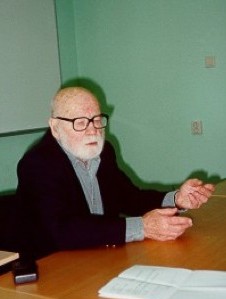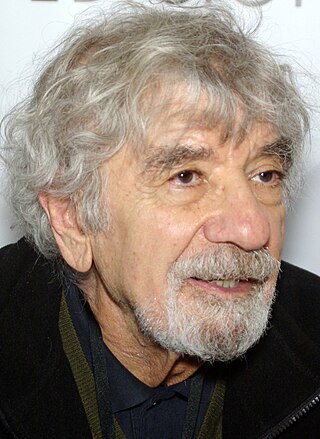Semiotics is the systematic study of sign processes (semiosis) and meaning making. Semiosis is any activity, conduct, or process that involves signs, where a sign is defined as anything that communicates something, usually called a meaning, to the sign's interpreter. The meaning can be intentional, such as a word uttered with a specific meaning; or unintentional, such as a symptom being a sign of a particular medical condition. Signs can also communicate feelings and may communicate internally or through any of the senses: visual, auditory, tactile, olfactory, or gustatory (taste). Contemporary semiotics is a branch of science that studies meaning-making and various types of knowledge.

Constructivism is a view in the philosophy of science that maintains that scientific knowledge is constructed by the scientific community, which seeks to measure and construct models of the natural world. According to the constructivist, natural science, therefore, consists of mental constructs that aim to explain sensory experience and measurements.
Cybernetics is a transdisciplinary approach for exploring regulatory systems, their structures, constraints, and possibilities, but has other definitions.

Sociocybernetics is an interdisciplinary science between sociology and general systems theory and cybernetics. The International Sociological Association has a specialist research committee in the area – RC51 – which publishes the (electronic) Journal of Sociocybernetics.

Thomas Albert Sebeok was a Hungarian-born American polymath, semiotician, and linguist. As one of the founders of the biosemiotics field, he studied non-human and cross-species signaling and communication. He is also known for his work in the development of long-time nuclear waste warning messages, in which he worked with the Human Interference Task Force to create methods for keeping the inhabitants of Earth away from buried nuclear waste that will still be hazardous 10,000 or more years in the future.
Second-order cybernetics, also known as the cybernetics of cybernetics, is the recursive application of cybernetics to itself and the reflexive practice of cybernetics according to such a critique. It is cybernetics where "the role of the observer is appreciated and acknowledged rather than disguised, as had become traditional in western science". Second-order cybernetics was developed between the late 1960s and mid 1970s by Heinz von Foerster and others, with key inspiration coming from Margaret Mead. Foerster referred to it as "the control of control and the communication of communication" and differentiated first order cybernetics as "the cybernetics of observed systems" and second-order cybernetics as "the cybernetics of observing systems". It is closely allied to radical constructivism, which was developed around the same time by Ernst von Glasersfeld. While it is sometimes considered a break from the earlier concerns of cybernetics, there is much continuity with previous work and it can be thought of as a distinct tradition within cybernetics, with origins in issues evident during the Macy conferences in which cybernetics was initially developed. Its concerns include autonomy, epistemology, ethics, language, reflexivity, self-consistency, self-referentiality, and self-organizing capabilities of complex systems. It has been characterised as cybernetics where "circularity is taken seriously".
Anthony George Wilden was a writer, social theorist, college lecturer, and consultant. Wilden published numerous books and articles which intersect a number of fields, including systems theory, film theory, structuralism, cybernetics, psychiatry, anthropological theory, water control projects, urban ecosystems, resource conservation, and communications and social relations.
Roy Ascott FRSA is a British artist, who works with cybernetics and telematics on an art he calls technoetics by focusing on the impact of digital and telecommunications networks on consciousness. Since the 1960s, Ascott has been a practitioner of interactive computer art, electronic art, cybernetic art and telematic art.
Ranulph Glanville was an Anglo-Irish cybernetician and design theorist. He was a founding vice-president of the International Academy for Systems and Cybernetic Sciences (2006–2009) and president of the American Society for Cybernetics (2009–2014).

Humberto Maturana Romesín was a Chilean biologist and philosopher. Many consider him a member of a group of second-order cybernetics theoreticians such as Heinz von Foerster, Gordon Pask, Herbert Brün and Ernst von Glasersfeld.
Management cybernetics is concerned with the application of cybernetics to management and organizations. "Management cybernetics" was first introduced by Stafford Beer in the late 1950s and introduces the various mechanisms of self-regulation applied by and to organizational settings, as seen through a cybernetics perspective. Beer developed the theory through a combination of practical applications and a series of influential books. The practical applications involved steel production, publishing and operations research in a large variety of different industries. Some consider that the full flowering of management cybernetics is represented in Beer's books. However, learning continues.
Klaus Krippendorff (1932–2022) was a communication scholar, social science methodologist, and cyberneticist. and was the Gregory Bateson professor for Cybernetics, Language, and Culture at the University of Pennsylvania's Annenberg School for Communication. He wrote an influential textbook on content analysis and is the creator of the widely used and eponymous measure of interrater reliability, Krippendorff's alpha. In 1984-1985, he served as the president of the International Communication Association, one of the two largest professional associations for scholars for communication.

The American Society for Cybernetics (ASC) is an American non-profit scholastic organization for the advancement of cybernetics as a science, a discipline, a meta-discipline and the promotion of cybernetics as basis for an interdisciplinary discourse. The society does this by developing and applying cybernetics’ concepts which are presented and published via its conferences and peer-reviewed publications. As a meta-discipline, it creates bridges between disciplines, philosophies, sciences, and arts. The ASC is a full member of the International Federation for Systems Research (IFSR).
Constructivist Foundations is an international triannual peer-reviewed academic journal that focuses on constructivist approaches to science and philosophy, including radical constructivism, enactive cognitive science, second-order cybernetics, biology of cognition and the theory of autopoietic systems, and non-dualizing philosophy. It was established in 2005 and the editor-in-chief is Alexander Riegler.
Gennady Simeonovich Osipov was a Russian scientist, holding a Ph.D. and a Dr. Sci. in theoretical computer science, information technologies and artificial intelligence. He was the vice-president of the Institute for Systems Analysis of the Russian Academy of Sciences, professor at the Moscow Institute of Physics and Technology, and at Bauman Moscow State Technical University. Osipov has contributed to the Theory of Dynamic Intelligent Systems and heterogeneous semantic networks used in applied intelligent systems.

Cybernetics is a wide-ranging field concerned with circular causal processes such as feedback. Norbert Wiener named the field after an example of circular causal feedback—that of steering a ship where the helmsman adjusts their steering in response to the effect it is observed as having, enabling a steady course to be maintained amongst disturbances such as cross-winds or the tide.
The following outline is provided as an overview of and topical guide to semiotics:
Laurence Dale Richards was a key figure in the modern development of cybernetics as a transdisciplinary field of inquiry, often referred to as the new cybernetics. He was the first to create interdisciplinary masters and doctoral programs in engineering management, with curricula built explicitly on concepts drawn from systems theory and cybernetics. He served as President for both the American Society for Cybernetics (1986–88) and the American Society for Engineering Management (1998–99) and was elected an Academician in the International Academy for Systems and Cybernetic Sciences in 2010.

Jason Jixuan Hu, is a Chinese American cyberneticist, independent scholar and managing director of WINTOP Organizational Learning Laboratory, and organizer/facilitator of the Club of Remy(Youtube Channel). He is noted for his work on "cognitive capacity in human communication, conflict resolution and cooperation solicitation," and on view on distance education in America.

Susan Petrilli is an Italian semiotician, professor of philosophy and theory of languages at the University of Bari, Aldo Moro, Italy, and the seventh Thomas A. Sebeok Fellow of the Semiotic Society of America. She is also International Visiting Research Fellow at the School of Psychology, the University of Adelaide, South Australia.








